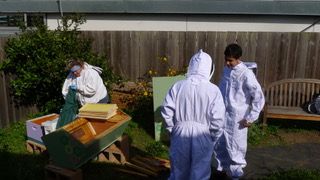During a good spring, the Lick-Wilmerding apple orchard is the home to two hives of honey bees that buzz around the apple blossoms and pollinate all of the flowers in the garden. However, there are currently no bees in the Lick hives.
A multitude of pests have driven out or killed the bees. Yellow jackets and fire ants are particular enemies of bees. These pests steal honey and wax and agitate the bee community. When the bees have been agitated, they fly outside the hive, or “swarm,” to find a new home. Lick’s Beekeeping Club plans to buy a new group of bees, a queen and a group of about 10,000 worker bees, for the school in mid-April at a cost of about $120. Unfortunately, their arrival will be too late for the apple blossoms on Lick’s trees. The bees will be bought from industrial almond farmers in Sacramento.
Mira Larrance ’20, co-leader of the Lick-Wilmerding Beekeeping Club, has worked on the hives for the past four years. “Basically, we buy a group of bees and a queen. When they arrive, we have to keep the queen in her box or else the other bees would kill her,” Larrance said, until “she lets out a pheromone to woo the workers into eating away at the marshmallow-cork which traps her.”
Nik Brocchini ‘16 started the Lick Beekeeping Club in 2013. “I was super into nature ever since I was a kid, but specifically bugs,” said Broccini, discussing how he started beekeeping. “My dad and I, when I was little, would talk about getting bees and I was super excited about it. When CCD (Colony Collapse Disorder) started when I was in middle school, my mom said that now would be a good time to make a hive to help bee numbers.”
His sophomore year, Brocchini, with the help of Dr. Anton Krukowski, a science teacher at Lick and Brocchini’s advisor, started the club. There were many interested kids and there was an excellent space in the gardens behind the development and business offices — there were lemon, apple, grapefruit, and other flowering trees and many flowers and herbs. According to Brocchini, one of the main challenges to the project was making a plan with Lick’s former CFO, Rick England, who was in charge of Lick’s safety insurance. Finally, Brocchini said, “at a certain point, no one was saying no to us, so we bought the bees…It was sort of an ‘ask for forgiveness not permission’ situation.”
Krukowski, still the advisor of Beekeeping Club, is an avid beekeeper—he has a hive at a friend’s house adjacent to his home on Bernal Heights.
“When a hive is thriving, the number of worker bees can reach tens of thousands, but when they reach the point of outgrowing their space, a new queen is born and is used to find a new place for half the hive to live,” says Krukowski. The hive behavior that bees exhibit is rare among insects, shared only by ants, termites and a few other ant-like species.
Bees make honey by collecting and eating the nectar of flowers, then digesting the nectar. Once back at the hive, the worker bee then will regurgitate the nectar into a slot of the honeycomb. Some of the extra water within the honey evaporates through the constant beating of wings within the hive, making the honey more concentrated.
“Bees are quite resourceful,” Krukowski says. “The dances they use to communicate the location of flowers or water is really intricate.” One of the challenges for bees in San Francisco is finding water to use during the dry summer.
Dr. Hannah Gaines, an entomologist (the study of insects) at the University of Wisconsin, Madison, focuses on bees. She has conducted volumes of research on the relationship between cranberry farming and bees.
Gaines emphasizes bees’ key role in farming. “Modern agriculture relies on this one species (the European Honey Bee), the bees that you see in the white boxes around central California. In recent years these bees have suffered vast reductions.” Each year, nationwide, a third of the population of European Honey Bee hives is lost. In California, the state with the most agricultural production, the almond industry alone needs around two million beehives to survive, according to a study from The Center for the American West at Stanford University.
Despite the vast reductions, through assiduous, continuous replenishment, the number of bees has increased over the last twenty years.
At the same time, the challenges to their population have doubled. “Other species are solitary, which means that there are an individual male and female,” Gaines said. “The honey and group culture of honey bees is extremely unique. There are no native honey bees in the United States.”
The social nature of the hive makes these bees particularly vulnerable to disaster. The spread of varroa mites, blood sucking external parasites native to East Asia, has killed large numbers of native species and honey bees in the United States. The mites attack both the adult and brood bees. Bees are also mortally impacted by many widely used agricultural pesticides, especially Neonicotinoids.






